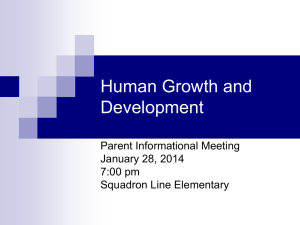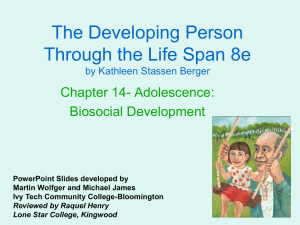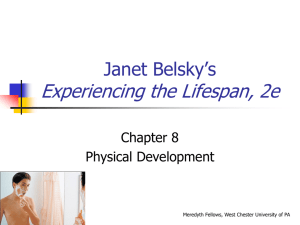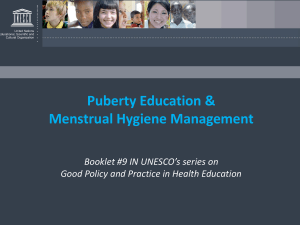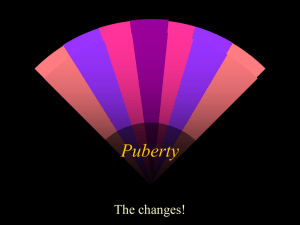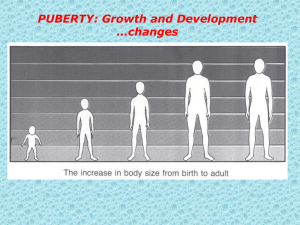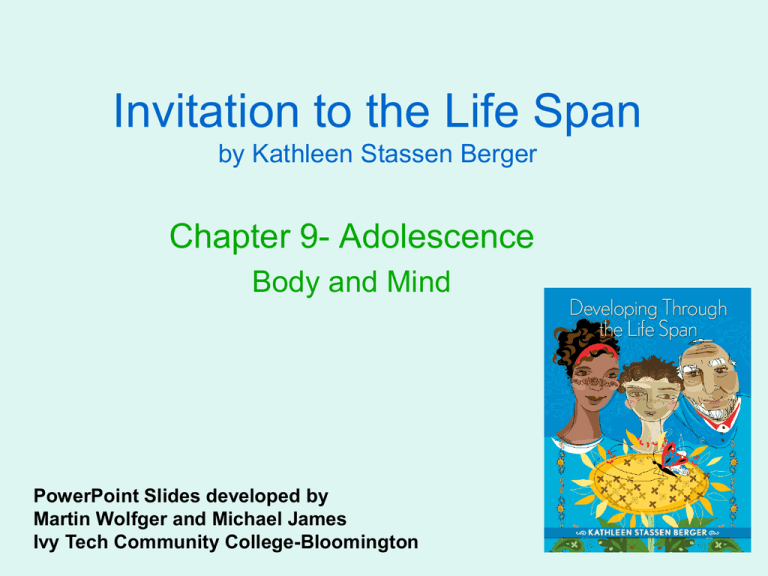
Invitation to the Life Span
by Kathleen Stassen Berger
Chapter 9- Adolescence
Body and Mind
PowerPoint Slides developed by
Martin Wolfger and Michael James
Ivy Tech Community College-Bloomington
Puberty
• The time between the first onrush of
hormones and full adult physical
development.
• Puberty usually lasts three to five years.
• Many more years are required to achieve
psychosocial maturity.
Puberty
• Menarche- A girl’s first menstrual period,
signaling that she has begun ovulation.
Pregnancy is biologically possible, but
ovulation and menstruation are often
irregular for years after menarche.
• Spermarche- A boy’s first ejaculation of
sperm. Erections can occur as early as
infancy, but ejaculation signals sperm
production.
Puberty Begins
Hormone
– An organic chemical substance that is
produced by one body tissue and conveyed
via the bloodstream to another to affect some
physiological function.
– Various hormones influence thoughts, urges,
emotions, and behavior.
Puberty Begins
Pituitary gland
– A gland in the brain that responds to a signal
from the hypothalamus by producing many
hormones, including those that regulate
growth and control other glands, among them
the adrenal and sex glands.
Puberty Begins
Adrenal glands-Two glands, located above
the kidneys, that produce hormones
(including the “stress hormones”
epinephrine [adrenaline] and
norepinephrine).
HPA (hypothalamus–pituitary–adrenal)
axis- The sequence of a chain reaction of
hormone production, originating in the
hypothalamus and moving to the pituitary
and then to the adrenal glands.
Puberty Begins
Gonads- The paired sex glands (ovaries in
females, testicles in males). The gonads
produce hormones and gametes.
Estradiol- A sex hormone, considered the chief
estrogen. Females produce more estradiol than
males do.
Testosterone- A sex hormone, the best known
of the androgens (male hormones). Secreted in
far greater amounts by males than by females.
Puberty Begins
Puberty Begins
Influences on the Age of Puberty
– Age 11 or 12 is the most likely age of visible
onset.
– The rise in hormone levels that signals
puberty is still considered normal in those as
young as age 8 or as old as age 14.
– Precocious puberty (sexual development
before age 8) occurs about once in 5,000
children, for unknown reasons.
Puberty Begins
– About two-thirds of the variation in age of
puberty is genetic.
– Genes on the sex chromosomes have a
marked effect on age of puberty. Girls
generally develop ahead of boys.
– Children who have a relatively large
proportion of body fat experience puberty
sooner than do their thin contemporaries.
Puberty Begins
– Leptin- A hormone that affects appetite and is
believed to be involved in the onset of puberty.
Leptin levels increase during childhood and
peak at around age 12.
– In both sexes, chronic malnutrition delays
puberty.
Puberty Begins
– Data on puberty over the centuries reveals a
dramatic example of a long-term statistical
increase or decrease called a secular trend.
– Each generation has experienced puberty a
few weeks earlier, and has grown a
centimeter or so taller, than did the preceding
one.
– The secular trend has stopped in developed
nations.
Puberty Begins
Too Early, Too Late
– Early-maturing girls tend to have lower selfesteem, more depression, and poorer body
image than later-maturing girls.
– Early-maturing boys are more aggressive,
lawbreaking, and alcohol-abusing than latermaturing boys.
– Slow developing boys tend to be more
anxious, depressed, and afraid of sex.
Puberty Begins
Nutrition
– Many adolescents are deficient in their intake
of necessary vitamins or minerals.
– Deficiencies of iron, calcium, zinc, and other
minerals may be even more problematic
during adolescence than vitamin deficiencies,
since minerals are needed for bone and
muscle growth.
– Nutritional deficiencies result from the food
choices that young adolescents are allowed,
even enticed, to make.
Puberty Begins
Body image
– A person’s idea of how his or her body looks.
– Another reason for poor nutrition is anxiety
about body image.
– Girls diet partly because boys tend to prefer to
date thin girls.
– Boys want to look taller and stronger, a
concern that increases from ages 12 to 17,
partly because girls value well-developed
muscles in males.
Puberty Begins
Eating Disorders
– anorexia nervosa- An eating disorder
characterized by self-starvation. Affected
individuals voluntarily under eat and often
over exercise, depriving their vital organs of
nutrition. Anorexia can be fatal.
– bulimia nervosa- An eating disorder
characterized by binge eating and subsequent
purging, usually by induced vomiting and/or
use of laxatives.
The Transformations of Puberty
Bigger and Stronger
Growth spurt
– The relatively sudden and rapid physical
growth that occurs during puberty.
– Each body part increases in size on a
schedule: A weight increase usually precedes
a height increase, and growth of the limbs
precedes growth of the torso.
– A height spurt follows the increase in body fat,
and then a muscle spurt occurs.
The Transformations of Puberty
Sexual Maturation
– Primary sex characteristics-The parts of the
body that are directly involved in reproduction,
including the vagina, uterus, ovaries, testicles,
and penis.
– Secondary sex characteristics- Physical
traits that are not directly involved in
reproduction but that indicate sexual maturity,
such as a man’s beard and a woman’s
breasts.
The Transformations of Puberty
– The primary and secondary sex
characteristics just described are not the only
manifestations of the sexual hormones.
– Fantasizing, flirting, handholding, staring,
displaying, and touching all reflect gender,
availability, and culture.
– Hormones trigger thoughts and emotions, and
the social context shapes thoughts.
The Transformations of Puberty
• Compared to 100 years ago, adolescent
sexual development is more hazardous,
for five reasons:
1. Earlier puberty and weaker social taboos
mean teens have sexual experiences at
younger ages. Early sex correlates with
depression and drug abuse.
2. Most contemporary teenage mothers have no
husbands to help them, whereas many
teenage mothers a century ago were married.
The Transformations of Puberty
3. Raising a child has become more complex
and expensive.
4. Mothers of teenagers are often employed
and therefore less available as caregivers for
their teenager’s child.
5. Sexually transmitted infections are more
widespread and dangerous.
The Transformations of Puberty
Teenage births in the past 50 years have
decreased markedly.
The Transformations of Puberty
• sexually transmitted infection (STI)
– A disease spread by sexual contact, including
syphilis, gonorrhea, genital herpes,
chlamydia, and HIV.
• child sexual abuse
– Any erotic activity that arouses an adult and
excites, shames, or confuses a child, whether
or not the victim protests and whether or not
genital contact is involved.
Cognitive Development
Neurological Development
Different parts of the brain grow at
different rates:
– The limbic system (fear, emotional impulses)
matures before the prefrontal cortex (planning
ahead, emotional regulation).
– That means the instinctual and emotional
areas develop before the reflective ones do.
Cognitive Development
– When emotions are intense, especially when
one is with peers, the logical part of the brain
shuts down.
– When stress, arousal, passion, sensory
bombardment, drug intoxication, or
deprivation is extreme, the adolescent brain is
overtaken by impulses that might shame
adults.
Cognitive Development
• Several aspects of adolescent brain
development are positive:
– increased mylenation, which decreases
reaction time
– enhanced dopamine activity, promoting
pleasurable experiences
– synaptic growth enhances moral development
and openness to new experiences and ideas
Cognitive Development
Thinking About Oneself
• adolescent egocentrism
– A characteristic of adolescent thinking that leads
young people (ages 10 to 14) to focus on themselves
to the exclusion of others.
• personal fable
– An aspect of adolescent egocentrism characterized
by an adolescent’s belief that his or her thoughts,
feelings, or experiences are unique, more wonderful
or awful than anyone else’s.
Cognitive Development
• invincibility fable
– An adolescent’s egocentric conviction that he or she
cannot be overcome or even harmed by anything that
might defeat a normal mortal, such as unprotected
sex, drug abuse, or high-speed driving.
• imaginary audience
– The other people who, in an adolescent’s egocentric
belief, are watching and taking note of his or her
appearance, ideas, and behavior. This belief makes
many teenagers self-conscious.
Cognitive Development
Formal Operational Thought
– In Piaget’s theory, the fourth and final stage of
cognitive development, characterized by more
systematic logic and the ability to think about
abstract ideas.
Hypothetical thought
– Reasoning that includes propositions and
possibilities that may not reflect reality.
Cognitive Development
• Deductive reasoning
– Reasoning from a general statement,
premise, or principle, through logical steps, to
figure out (deduce) specifics. (Sometimes
called top-down reasoning.)
• Inductive reasoning
– Reasoning from one or more specific
experiences or facts to a general conclusion;
may be less cognitively advanced than
deduction. (Sometimes called bottom-up
reasoning.)
Teaching and Learning
– Adolescent cognitive growth benefits from
shared experiences and opinions.
– Often communication via the Internet bolsters
fragile self-esteem.
– Adolescents sometimes share personal
information online without thinking about the
possible consequences.
Teaching and Learning
– Cyberbullying- Bullying that occurs via
Internet insults and rumors, texting,
anonymous phone calls, and video
embarrassment.
– Some fear that the anonymity provided by
electronic technology brings out the worst in
people.
– One expert on bullying believes that
cyberbullying is similar to other forms, new in
mode but not in intent or degree of harm.
Teaching and Learning
Entering a New School
– The transition from one school to another often
impairs a young person’s ability to function and learn.
– Changing schools just when the growth spurt is
occurring and sexual characteristics are developing is
bound to create stress.
– The first year in any new school (middle school, high
school, or college) correlates with increased bullying,
decreased achievement, depression, and eating
disorders.
Teaching and Learning
– High School
– In theory and sometimes in practice, high
schools promote students’ analytic ability.
– In the United States, an increasing number of
high school students are enrolled in classes
that are designed to be more rigorous and
that require them to pass externally scored
exams.
– Another manifestation of the trend toward
more rigorous education is the greater
number of requirements that all students must
Teaching and Learning
high-stakes test
– An evaluation that is critical in determining
success or failure.
– A single test that determines whether a
student will graduate or be promoted is a
highstakes test.
Teaching and Learning
– In the United States, one result of pushing
almost all high school students to pursue an
academic curriculum is that more are
prepared for college.
– Another result is that more students drop out
of high school.


